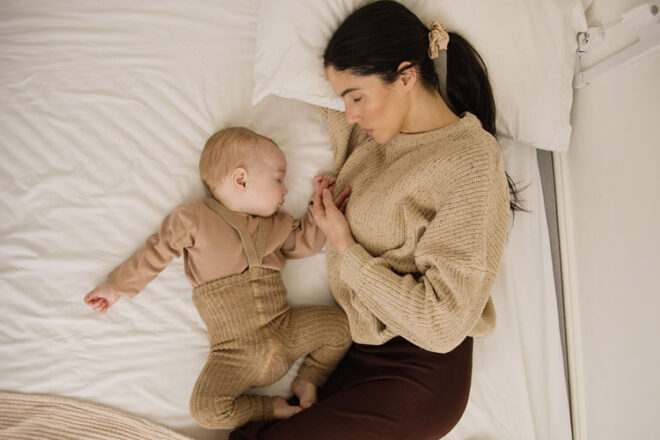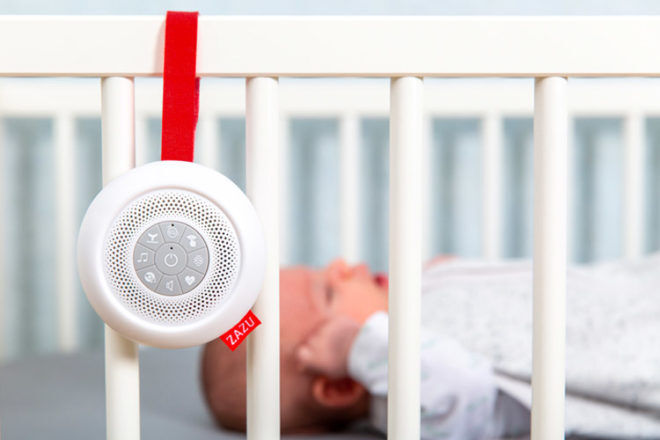
As your baby gets a little older, that dream of a full night’s sleep can become a reality. And while some babies are regular sleep champions, many need a little helping hand to learn the skills needed to sleep through the night. Enter: sleep training.
There’s no one ‘right way’ to go about this, and you know your bub best, so be guided by them and what works for your family. With a little consistency and a big tuck-in, your baby may just master their next life skill – the art of the (fingers crossed) 12-hour sleep.
What exactly is sleep training?

In a nutshell, sleep training is how you teach your baby to fall asleep and stay asleep for long, glorious hours through the night.
Every baby is different, and sometimes sleep training is easier said than done. However, if you choose the right age and find the right technique, sleep training might just help your baby become a professional snooze monster.
When should you start sleep training?

It’s best to establish a consistent time for going to bed and a bedtime routine (such as bath, book and big cuddle) before you start sleep training.
Then, between four and six-months-old is a good age to start bub’s ‘sleep education’. This is because your baby can go for a longer time without needing food top-ups and is developing a regular sleep-wake cycle (as opposed to when they’re tiny and need lots of night feeds, and lots and lots of sleep).
Once bub is ready, here are eight sleep training techniques that may help the whole family sleep easy. Keep in mind that different things work for different babies though, and do what feels right for yours.
Here are 8 ways to help your baby learn their A, B, Zzzzzzzzzs.
1. Fading into dreamland
There are a few different ‘fading methods‘, but, generally speaking, it involves parents gradually reducing the amount of time they spend helping baby fall asleep. Over time, bub learns how to get to sleep with less and less help from you.
In this version of fading, mum or dad slowly reduces the amount of time spent directly comforting a stubborn sleeper (e.g. through rocking or feeding) so that bub becomes less reliant on this contact in order to go to sleep.
2. Clock watching
Another take on ‘fading’ is to tuck your bub into bed, then leave the room. Every few minutes, you go in to check them, and give some reassurance, until they’re asleep.
3. Take a seat
The ‘chair method’ is another ‘fading’ technique. The idea is that you sit next to bub’s cot as they go to sleep, then gradually move your chair further away each night, until it’s outside the nursery altogether.
4. A little pick-me-up
The ‘pick-up-put-down method’ gives your biceps a workout! With this technique, you pick up your baby to comfort them but put them back in the cot before they are asleep, repeating as necessary until they’re sound asleep. For some bubs, this is a cue for sleep, and for others, it’s a wake-up call, so see how you go.
5. Crying it out
With the ‘cry it out’ techniques, it’s ok to let your baby cry in between going into the nursery to comfort them. A well-known version of this is the ‘Ferber method’, created by a paediatrician called Richard Smith (oh ok, Richard Ferber!)
His idea is that you put bub into their cot awake, then leave the room. You check on them at regular intervals (comforting them with a little pat, but not a pickup), and let your baby cry in between checks. Over time, the checks become further and further apart and your little one learns to put themselves to sleep.
As with all the techniques, you’ll be guided by how you feel and how bub responds, although ‘crying it out’ can be a little bit trickier if older siblings are trying to sleep.
6. An expert opinion
If you’ve tried everything and remain seriously sleep-deprived, it might help to speak to a paediatrician, call a parent helpline or visit a ‘sleep school’. There is some more information here.
7. All good?
On the flip side, some babies sleep well without any training, and some parents are happy to let bub do their own thing. If your family is ok with the status quo, then just keep doing what you’re doing (or not doing!)
8. Tick, tock, toddler clock
If your baby has grown into a toddler and still needs a bit of sleep ‘guidance’, then a sleep training clock can help them tell night from day. The gro clock is one popular way to teach your toddler about time (and what is a reasonable hour to get Mum up!)
And remember…

Every child is different, so what works for your first bub may not work for your second. Some kids sleep like little logs from the get-go, while others are up and down like yo-yos. Parents are also different and what feels right for one family might not gel with another.
Whatever your sleep training method, be consistent and give the technique a go for at least a week. If it doesn’t work, there’s no harm in trying another approach.
And if your sleep-trained tot ‘unlearns’ their good habits, then don’t worry. Growth spurts, illness and travel can mess with sleep patterns, so think about what worked the first time and what might work this time around.
Good night and good luck!
Want to read more…… try these:
How to understand different baby cries.
The lost sleep calculator for tired mums.
Safe swaddling for babies: what you need to know.



